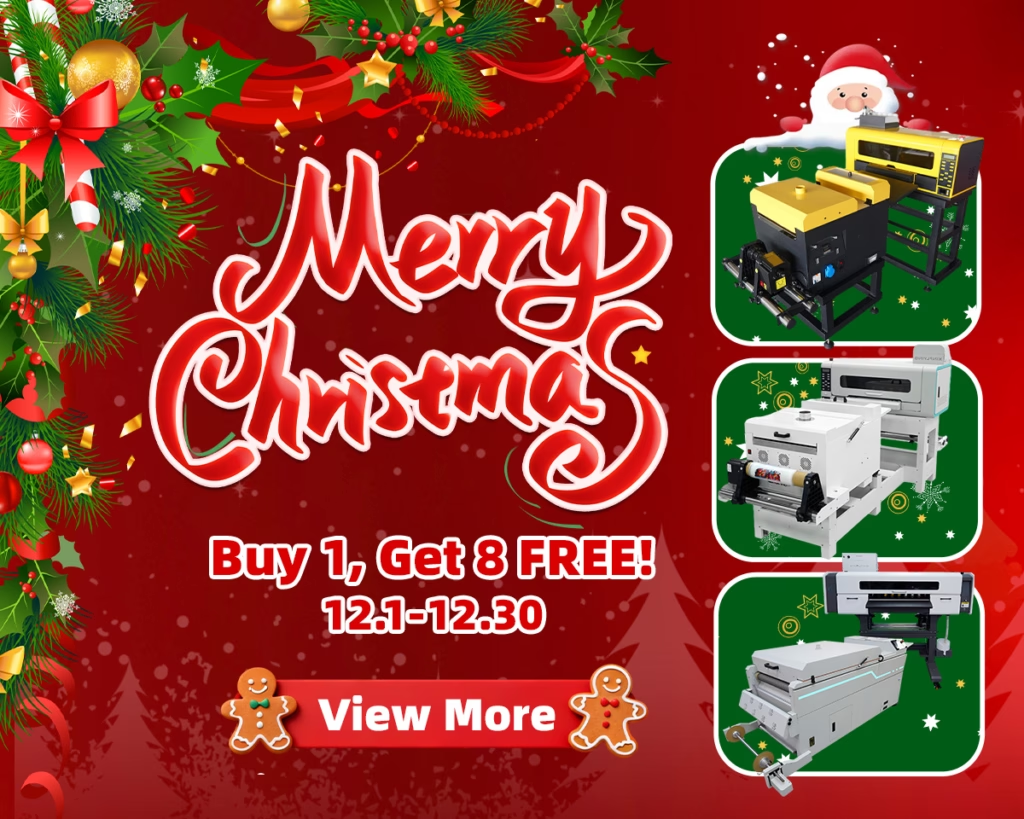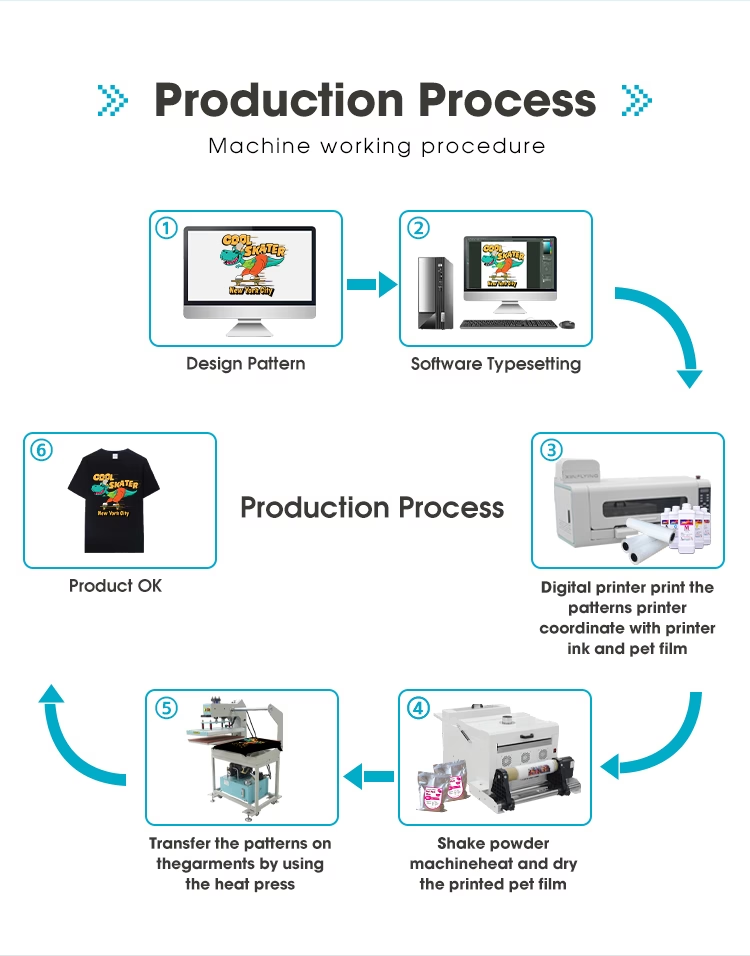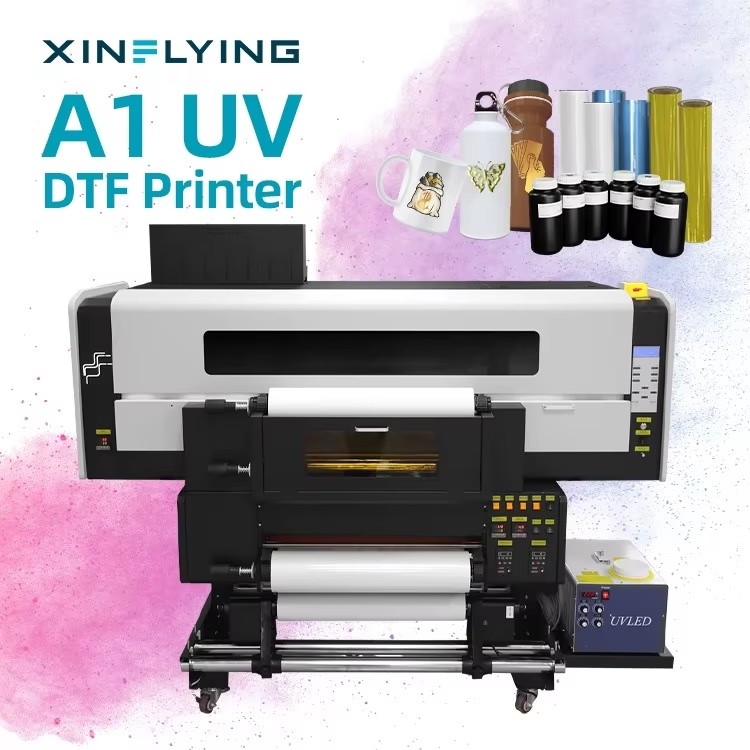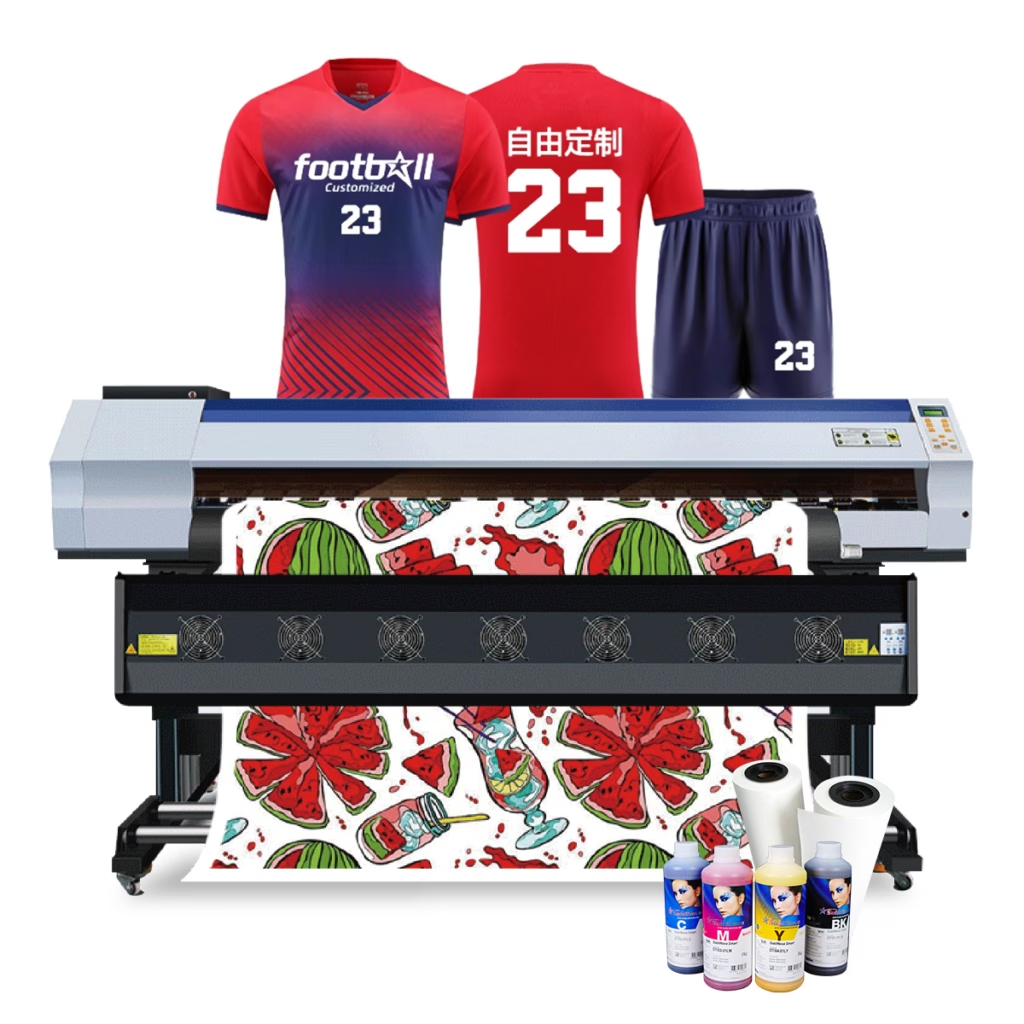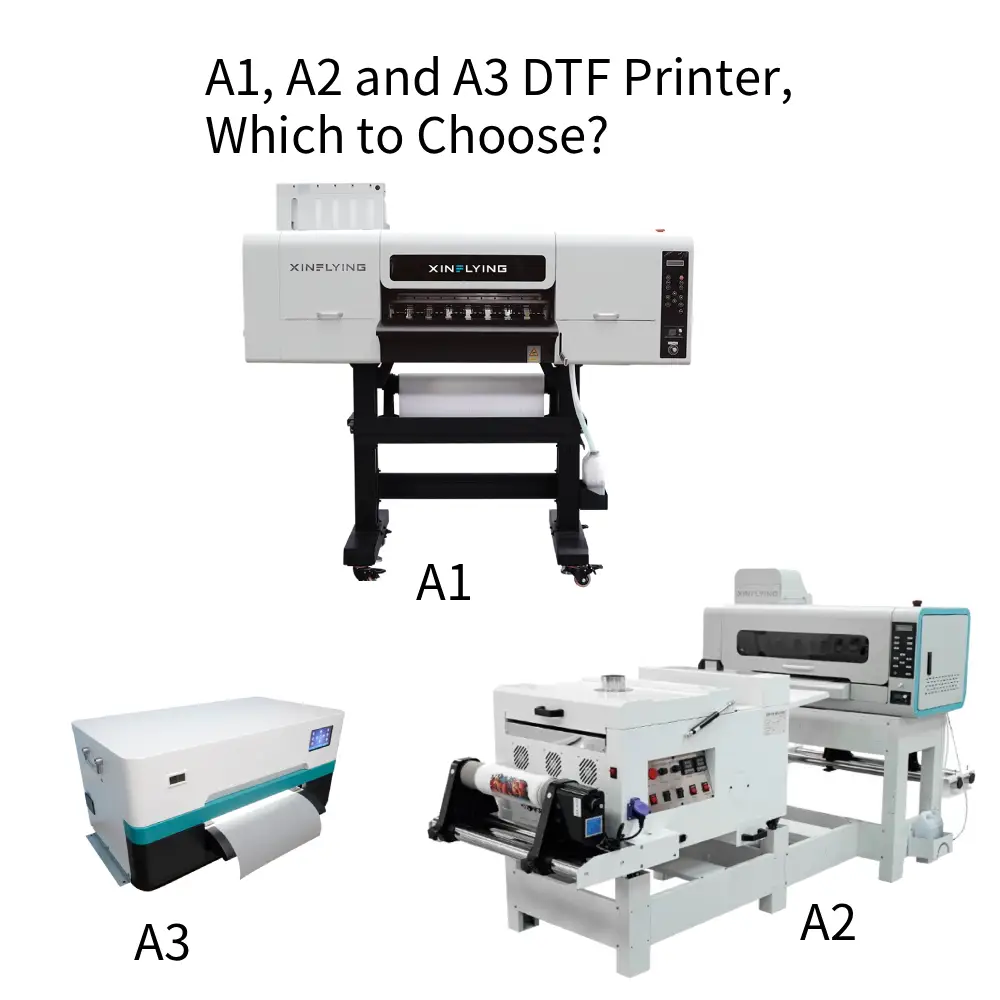Cuando se trata de imprimir diseños sobre tela, Hay varios métodos disponibles en el mercado.. Dos técnicas populares son Direct-to-Fabric (DTF) impresión e impresión por sublimación. en este blog, exploraremos sus principios básicos, diferencias clave, aplicaciones, pros y contras, y, en última instancia, determinar qué método se adapta mejor a los requisitos específicos..
Impresión DTF básica

¿Qué es la impresión DTF??
impresión DTF, también conocido como Impresión directa sobre tela, Es una técnica de vanguardia que se utiliza para transferir diseños a varios tipos de tela.. Este método implica imprimir diseños en una película especial., que luego se transfiere a la tela usando calor y presión.. El proceso permite una alta calidad., estampados vibrantes en una amplia gama de telas, convirtiéndolo en una opción popular en la industria textil. A diferencia de los métodos tradicionales, La impresión DTF ofrece la flexibilidad de crear patrones complejos e imágenes vívidas que destacan en las prendas..
¿Cómo funciona la impresión DTF??
El proceso de cómo funciona la impresión DTF comienza con la creación del diseño deseado en una computadora.. Una vez que el diseño esté listo, se imprime en una película especial usando tinta DTF. Luego la película impresa se coloca sobre la tela., y ambos se someten a calor y presión utilizando una máquina de prensa de calor..
Durante este paso, La tinta de la película sufre un cambio de fase de sólida a gaseosa sin pasar por la fase líquida.. Esto permite que las partículas de tinta se incrusten directamente en las fibras de la tela., dando como resultado impresiones duraderas y vibrantes.
Impresión por sublimación básica
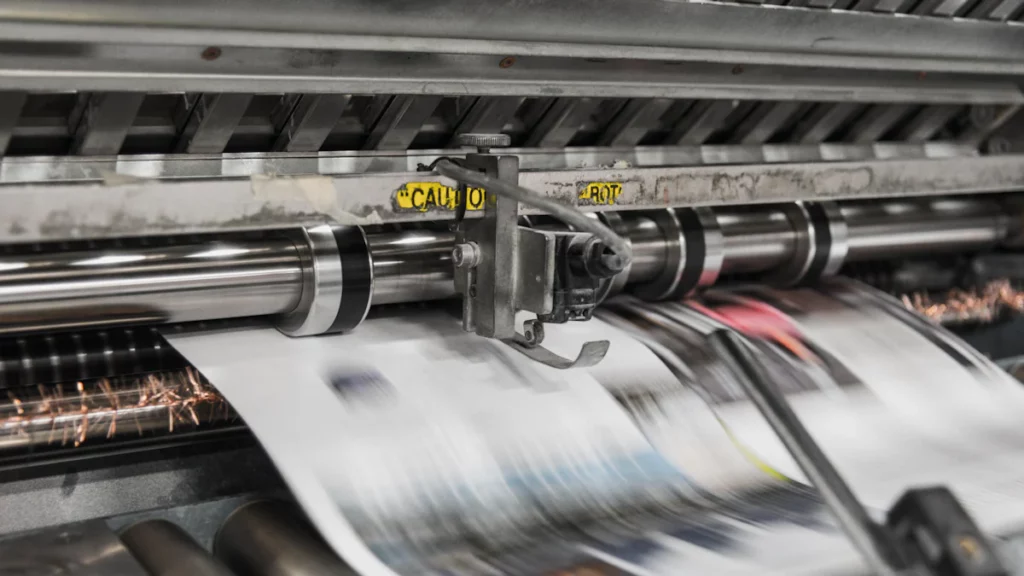
¿Qué es la impresión por sublimación??
Impresión por sublimación Es un método de vanguardia que se utiliza para transferir diseños a la tela mediante calor y presión.. Este proceso implica la transformación de partículas de tinta sólidas a un estado gaseoso sin pasar por la fase líquida.. Luego, el gas impregna la tela y se solidifica., dando como resultado impresiones vívidas y duraderas. A diferencia de los métodos de impresión tradicionales, La impresión por sublimación ofrece la flexibilidad de crear patrones e imágenes complejos que permanecen vibrantes incluso después de múltiples lavados..
¿Cómo funciona la impresión por sublimación??
El proceso comienza con la creación del diseño deseado en una computadora.. Una vez finalizado el diseño, está impreso en especial papel de sublimación usando tintas de sublimación. Luego el papel impreso se coloca sobre la tela., y ambos se someten a calor y presión utilizando una máquina de prensa de calor..
Durante este paso, la tinta se sublima, pasar de un estado sólido directamente a un estado gaseoso. La alta temperatura hace que las partículas de tinta se abran y se fusionen con las fibras de la tela., dando como resultado impresiones que están incrustadas dentro de la propia tela.
Diferencias clave entre DTF y la impresión por sublimación
Ahora, profundicemos en las diferencias clave entre la impresión DTF y la sublimación, centrándose en el proceso de solicitud, compatibilidad de la tela, y vitalidad del color.
Proceso de solicitud
La impresión DTF implica transferirla a una película y luego aplicarla a la tela con calor y presión.. Ofrece más estabilidad en las transferencias y la posibilidad de almacenarlas a largo plazo..
La impresión por sublimación transfiere partículas de tinta sólidas a un estado gaseoso sin fase líquida.. Esto da como resultado flores de colores consistentes y estampados vibrantes..
Compatibilidad de telas
La impresión DTF es versátil y se puede aplicar a una amplia gama de tejidos., haciéndolo adecuado para varios proyectos.
La impresión por sublimación funciona mejor en sustratos recubiertos de poliéster y polímeros., haciéndolo ideal para ropa deportiva y artículos personalizados..
Vibrancia del color
La impresión DTF ofrece resultados vibrantes en cualquier color de tela, mientras que la sublimación funciona mejor en telas de colores claros y no imprime eficazmente en blanco.
Durabilidad
Las impresiones DTF son duraderas y pueden resistir el desgaste., con transferencias que resisten la decoloración y mantienen la claridad con el tiempo.
Las impresiones por sublimación son muy duraderas., especialmente en poliéster, debido a la transformación de gas a sólido de las partículas de tinta, lo que garantiza que los diseños se integren en la tela..
Pros y contras de la impresión DTF
Ahora que hemos explorado los principios básicos de DTF e impresión por sublimación, profundicemos en las ventajas y desventajas específicas de impresión DTF. Comprender estos aspectos clave proporcionará información valiosa sobre la idoneidad de este método para diversas aplicaciones..
Ventajas de la impresión DTF
1. Colores vibrantes
Una de las ventajas más destacadas de impresión DTF es su capacidad para producir colores vibrantes y llamativos en la tela. El proceso permite una saturación de color excepcional., dando como resultado diseños que resaltan con viveza. Esta característica hace impresión DTF una opción ideal para aplicaciones donde la intensidad del color es una prioridad, como ropa de moda, camisetas deportivas, y mercadería promocional.
2. Ideal para diseños complejos
Otro beneficio significativo de impresión DTF es su capacidad para representar diseños intrincados y detallados con precisión. Ya sean patrones intrincados, lineas finas, o gráficos elaborados, ¿Qué es la impresión DTF? destaca en capturar los matices de diseños complejos. Esto lo convierte en la opción preferida para crear prendas y accesorios visualmente llamativos que exigen impresiones de alta resolución..
Contras de la impresión DTF
1. No apto para todos los tejidos.
Mientras que la impresión DTF ofrece versatilidad en términos de compatibilidad de tejidos., Puede que no sea adecuado para todo tipo de tejidos.. Ciertos materiales o mezclas especializados pueden plantear desafíos al utilizar este método., Requerir que los decoradores evalúen cuidadosamente las características de la tela antes de continuar con la impresión DTF.. Es fundamental tener en cuenta factores como la composición del tejido., textura, y tejer para garantizar resultados óptimos.
2. Proceso más largo en comparación con otros métodos.
Otra consideración al utilizar la impresión DTF es el tiempo requerido para todo el proceso.. Desde preparar el diseño y la película hasta transferirlo a la tela., Este método normalmente implica un tiempo de procesamiento más largo en comparación con algunas técnicas alternativas.. Si bien los resultados a menudo valen la pena la inversión de tiempo, Los decoradores deben tener en cuenta los plazos de producción al elegir qué es la impresión DTF para sus proyectos..
Pros y contras de la impresión por sublimación
Ahora, Exploremos las ventajas y desventajas específicas de la impresión por sublimación.. Comprender estos aspectos clave proporcionará información valiosa sobre la idoneidad de este método para diversas aplicaciones..
Ventajas de la impresión por sublimación
1. Impresiones duraderas
La impresión por sublimación ofrece una durabilidad excepcional, lo que lo convierte en la opción preferida para aplicaciones que requieren diseños duraderos. El proceso consiste en transformar partículas de tinta sólidas en estado gaseoso., permitiéndoles impregnar la tela y solidificarse. Esto da como resultado impresiones que quedan incrustadas dentro de la propia tela., mejorando su resistencia a la decoloración y al desgaste. ¿Qué es la impresión por sublimación? Garantiza que los diseños mantengan su vitalidad y claridad a lo largo del tiempo., incluso después de múltiples lavados y uso prolongado.
2. Adecuado para una amplia gama de tejidos.
Una de las ventajas más destacadas de la impresión por sublimación es su compatibilidad con una amplia gama de tejidos., incluyendo sustratos recubiertos de poliéster y polímero. Esta versatilidad lo hace ideal para diversas aplicaciones, como ropa deportiva., artículos de promoción, regalos personalizados, y más. La capacidad de producir impresiones vibrantes en diferentes tipos de telas amplía los usos potenciales de la impresión por sublimación en diferentes industrias..
Contras de la impresión por sublimación
1. Opciones de color limitadas
Una limitación de la impresión por sublimación son sus opciones de color relativamente limitadas en comparación con otros métodos de impresión.. Si bien destaca por producir colores vibrantes en telas compatibles, Puede haber limitaciones al intentar lograr tonos o tonos específicos.. Los decoradores deben evaluar cuidadosamente sus requisitos de color y considerar métodos alternativos si buscan un espectro de colores más amplio para sus diseños..
2. No es ideal para telas oscuras.
Otra consideración a la hora de utilizar la impresión por sublimación es su compatibilidad con los colores de las telas.. Este método no es ideal para telas de colores oscuros debido a que depende de una capa base blanca para lograr una intensidad de color óptima.. Si bien destaca por producir estampados vívidos en telas de colores claros, Es posible que los decoradores necesiten explorar técnicas alternativas cuando trabajen con tonos de tela más oscuros..
Sublimación vs DTF, Cuál elegir?
Al decidir entre sublimación y DTF (Directo a la película) métodos de impresión, es importante considerar sus necesidades específicas y las características de cada método. Aquí hay algunos factores a considerar al elegir entre sublimación e impresión DTF:
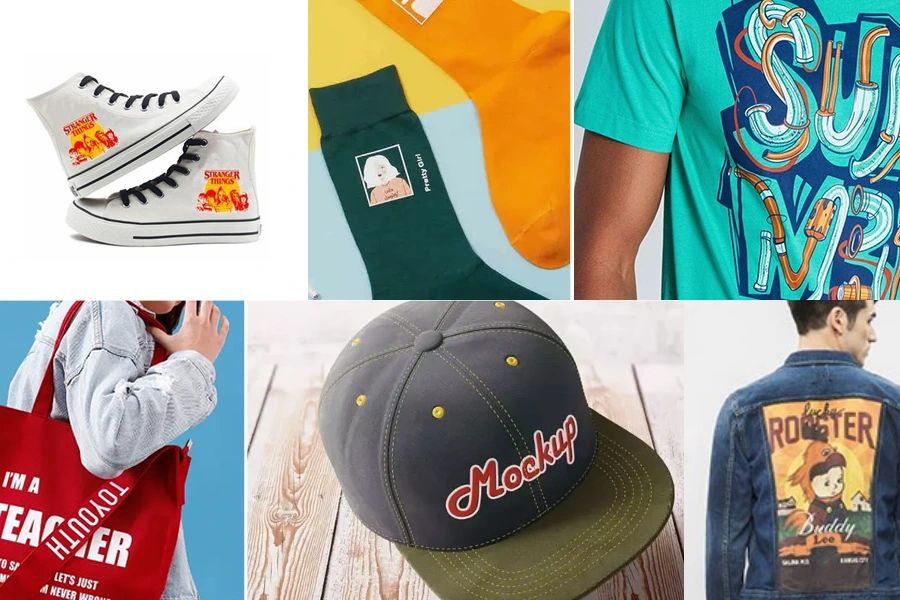
Tipo de tela
La sublimación se utiliza normalmente en tejidos a base de poliéster., mientras que DTF se puede utilizar en una gama más amplia de tejidos, incluyendo algodón, poliéster, y mezclas. Si trabaja principalmente con tejidos de poliéster, La sublimación puede ser la mejor opción.. Si trabaja con una variedad de tipos de telas, DTF puede ofrecer más flexibilidad.
Vibrancia del color
La impresión por sublimación generalmente produce colores más vibrantes y duraderos en comparación con la impresión DTF.. Si la calidad del color es una prioridad para tus proyectos, La sublimación puede ser la mejor opción.- Detalle y resolución: La impresión DTF permite mayor detalle y resolución en comparación con la impresión por sublimación. Si está trabajando en diseños o patrones complejos, DTF puede ofrecer mejores resultados.
Costo y equipo
La impresión por sublimación requiere tintas de sublimación especializadas, impresoras, y papel de transferencia, que puede ser más caro que el equipo de impresión DTF. La impresión DTF puede ser una opción más rentable para quienes buscan iniciar un negocio de impresión con un presupuesto limitado..
Facilidad de uso
La impresión por sublimación implica un proceso de transferencia de calor., mientras que la impresión DTF requiere el uso de un polvo termofusible y una prensa térmica. Algunos usuarios pueden encontrar que la sublimación es más sencilla y fácil de usar., mientras que otros pueden preferir las mayores opciones de control y personalización que ofrece la impresión DTF.
Respetuoso con el medio ambiente
La impresión por sublimación se considera más respetuosa con el medio ambiente, ya que produce un mínimo de residuos y no requiere el uso de agua ni disolventes. La impresión DTF puede producir más residuos debido a la película de transferencia utilizada en el proceso..
¿Puedo utilizar polvo DTF en papel de sublimación??
No, El polvo DTF no es compatible con el papel de sublimación. El polvo DTF está diseñado para usarse con películas DTF, mientras que el papel de sublimación se utiliza con tintas de sublimación para un proceso de impresión diferente. Mezclar los dos puede resultar en una mala calidad de transferencia y daños al equipo.. Es importante utilizar los materiales correctos para cada método de impresión..
¿Es DTF mejor que la sublimación??
La elección entre DTF (Directo a la película) y la impresión por sublimación depende de sus necesidades y preferencias específicas. Ambos métodos tienen sus propias ventajas y limitaciones.:
Impresión DTF
- Permite imprimir en una gama más amplia de tejidos., incluyendo algodón, poliéster, y mezclas.
- Ofrece mayor detalle y resolución para diseños complejos..
- Puede lograr un acabado más texturizado en comparación con la sublimación..
- Permite imprimir con tinta blanca sobre telas oscuras..
Impresión por sublimación
- Produce colores vibrantes y duraderos., especialmente en tejidos a base de poliéster.
- Más respetuoso con el medio ambiente, ya que produce residuos mínimos y no requiere agua ni disolventes.
- Fácil de usar e ideal para imprimir en artículos como prendas de vestir., tazas, y productos promocionales.
- Adecuado para producción de gran volumen y personalización en masa.
Conclusión
En esencia, Los decoradores y fabricantes deben evaluar cuidadosamente sus requisitos específicos al elegir entre los métodos de impresión DTF y por sublimación.. La decisión debe basarse en factores como la flexibilidad de la aplicación., compatibilidad de la tela, opciones de color, y consideraciones de durabilidad. En general, Ambas técnicas ofrecen soluciones valiosas para crear estampados vibrantes y duraderos en diversos tejidos., Contribuyendo al panorama en constante evolución de la decoración textil..
